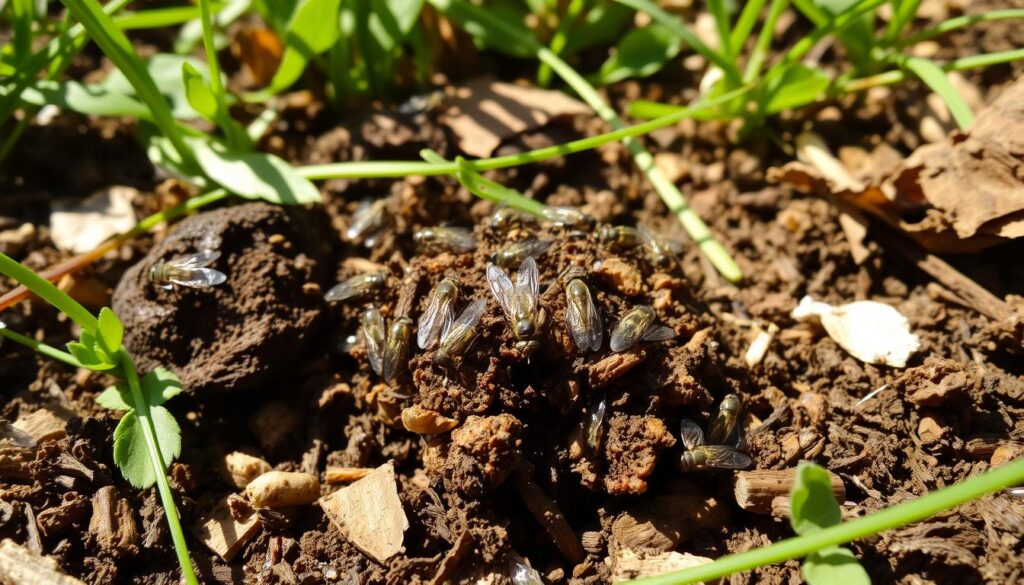Did you know a pair of flies could lead to over 191 quintillion flies by August? It’s shocking. Flies are more than a bother; they’re a health risk. They carry over 100 diseases and bacteria, harming humans and animals.
To control flies, we must understand their life cycle. We need to use effective ways to stop them.
Key Takeaways
- Flies can reproduce quickly, with female houseflies laying up to 100 eggs at a time and reproducing in multiple batches.
- The fly life cycle comprises four stages: egg, larva (maggots), pupa, and adult, often taking less than two weeks in warm weather.
- Moisture is essential for the survival of fly eggs, larvae, and pupae, so managing organic waste and standing water is crucial.
- Integrated pest management, combining prevention and non-chemical control methods with judicious use of pesticides, is the best approach to controlling flies.
- Fly traps and baits can be effective in areas where chemical sprays are prohibited, but must be used responsibly.
Understanding the Fly Life Cycle
Learning about the fly life cycle helps us understand how they breed. This knowledge is key to stopping them. Flies go through four main stages, each important for their growth and making more flies.
Egg Stage
The female fly lays her eggs near food or rotting stuff. She can lay up to 100 eggs at once. These eggs hatch in just 24 hours, starting the next stage.
Larvae (Maggot) Stage
The tiny larvae, or maggots, are white and have no legs. They eat a lot where they were born. This stage lasts three to five days, getting ready for the next phase.
Pupal Stage
In this stage, the larvae turn into pupae. They look darker and stay still for three to six days. This is when they turn into adult flies, a big step in their life.
Adult Fly Stage
The last stage is when the new flies start their life again. A housefly lives for 15 to 30 days. Things like where they live and the weather affect how long they live.
Knowing about the fly life cycle helps us stop them from breeding. By focusing on certain stages, we can cut down their numbers.
| Fly Life Stage | Duration | Key Characteristics |
|---|---|---|
| Egg | 24 hours | Female flies can lay up to 100 eggs at a time, often in multiple batches. |
| Larvae (Maggot) | 3-5 days | Legless, white insects that feed at the site where they hatched. |
| Pupal | 3-6 days | Larvae develop a darker outer shell and remain inactive as they transform into adult flies. |
| Adult | 15-30 days | Lifespan of a housefly, with factors like location and temperature affecting longevity. |
“The life cycle of a fly is a remarkable and complex process, with each stage playing a crucial role in the survival and reproduction of these fascinating insects.”
Knowing the fly life cycle helps us fight their breeding. This knowledge is key to keeping our places clean and healthy.
Identifying Fly Breeding Grounds
It’s key to find and get rid of places where flies breed. Flies like places with rotting stuff. This is where they lay their eggs.
Places like dung, garbage, and food waste are perfect for them. These spots help flies multiply.
Seeing maggots means eggs are there. Maggots are hard to miss in trash or food. Places like rotting foundations and dirty spots around your home can also attract flies. Fixing these areas stops flies from breeding.
| Fly Breeding Grounds | Characteristics |
|---|---|
| Organic Waste | Dung, excrement, garbage, and food processing waste provide an ideal medium for fly breeding. |
| Moist, Decaying Matter | Flies are attracted to moist, decaying organic materials like rotting vegetation, compost heaps, and sewage sludge. |
| Unsanitary Conditions | Poor sanitation and hygiene, such as uncleaned drains, cesspools, and cesspits, can create fly breeding sites. |
Female flies can lay up to 100 eggs at once. One fly can lay over 500 eggs in her life. Eggs hatch fast, in 8 to 20 hours. This means flies can grow quickly. By getting rid of fly breeding spots, you can stop them from coming back.
“Identifying and eliminating the breeding sites of flies is crucial in breaking their breeding cycle.”

Eliminating Moisture Sources
Moisture helps flies breed. To stop them, we must get rid of standing water and manage waste well. By controlling moisture, we can stop flies from breeding and keep them away.
Removing Standing Water
Flies like water to lay eggs. Look around your place for water pools. Fix ditches, change animal water, and empty old buckets to stop flies.
Managing Organic Waste
It’s important to handle waste right. Cover muck heaps and clean up rotting stuff. This stops flies from breeding.
Controlling moisture and waste is key to stopping flies. It’s the first step to break the fly breeding cycle.
“Controlling moisture and organic waste is the foundation of effective fly prevention. It’s an essential first step in breaking the fly breeding cycle.”
Using Fly Traps and Baits
First, get rid of where flies breed. Then, catch the adult flies. Fly traps are great for catching flies outside your home. They use bait to attract and trap flies.
For inside, use traps that look nice but catch flies. They help keep your home clean.
Outdoor traps, like the Garbage Guard® Trash Can Insect Killer, kill flies near bins. They use a special vapour. These traps can catch lots of flies.
Fly baits with insecticides and pheromones also work. They stop maggots from becoming flies. They kill flies fast, which is good for places like food factories.
| Fly Control Product | Active Ingredient | Key Benefits |
|---|---|---|
| Twenty One | Pyrethrin | Effective for 12 weeks, can be sprayed or painted for immediate results |
| Maggots | Cyromazine | Prevents maggots from developing into adult flies, results visible in 2 weeks |
| Sheila | Sex Pheromones | Lures flies to the bait, causing almost instant death on contact |
The pest control market is big, worth USD 19.1 billion. This shows how important it is to control flies. Using traps and baits helps keep us safe from diseases.
“Flies can carry up to 100 different pathogens, with a single house fly potentially carrying up to 1.9 million bacteria on its body and 33 million in its gut, underscoring the potential health risks associated with fly infestations.”
Using traps, baits, and keeping things clean helps stop flies. This makes our homes and work places safer and cleaner.
Fly breeding cycle
Flies can quickly start infestations. Their life cycle has four stages and can finish in two weeks in warm weather. Knowing their life stages helps us stop their breeding.
Rapid Fly Reproduction
A female fly can lay hundreds of eggs. The larval stage, or maggots, can last from days to weeks. After growing, maggots turn into pupae and then into adult flies.
Fly Life Stages
- Egg Stage: Flies lay eggs in moist, organic matter. The eggs hatch into larvae in days.
- Larvae (Maggot) Stage: Fly larvae grow from 2 mm to 20 mm in four days. They moult twice.
- Pupal Stage: Maggots turn into pupae, where they change into adult flies.
- Adult Fly Stage: Adult flies live from days to months. They mate and lay eggs again.
Flies reproduce quickly and have many life stages. This makes them hard to control. Knowing their cycle helps us keep places fly-free.
| Fly Life Stage | Duration | Key Characteristics |
|---|---|---|
| Egg | 2-3 days | Flies lay hundreds of eggs in moist, organic matter. |
| Larvae (Maggots) | 5-20 days | Maggots can grow from 2 mm to 20 mm in length, moulting twice. |
| Pupae | 5-14 days | Maggots transform into the pupal stage, undergoing metamorphosis. |
| Adult Fly | 7-90 days | Adult flies can live for a few days to a few months, depending on the species. |
Knowing the fly breeding cycle helps us fight them. By targeting each stage, we can keep places fly-free.
Chemical Control Methods
Prevention is key in fighting flies. But, chemical methods are also important. In the UK, area sprays and residual sprays are used.
Area Sprays
Area sprays kill flies on contact. They are fine mist insecticides. These sprays work fast but only last 1-2 hours.
Residual Sprays
Residual sprays are for shaded areas like walls and ceilings. They kill flies when they touch the treated surfaces. These sprays last longer but can be washed away.
Switching between area and residual sprays is wise. It stops flies from getting used to one type of spray. This keeps the flies from becoming resistant.
| Chemical Fly Control Method | Description | Efficacy | Drawbacks |
|---|---|---|---|
| Area Sprays (Knockdown) | Fine mist insecticides that kill adult flies on contact | Rapid knockdown of adult fly populations | Short-lived effect (1-2 hours) due to rapid evaporation |
| Residual Sprays | Insecticides applied to surfaces, killing flies on contact | Longer-lasting effect than area sprays | Susceptible to being washed off by water (e.g., cleaning) |
Using chemicals with other methods is best. This includes getting rid of places where flies breed and managing waste. This way, you keep flies away and avoid resistance.

Integrated Pest Management Approach
Controlling flies is best done with an integrated pest management (IPM) plan. This plan uses prevention, non-chemical methods, and careful use of pesticides. It’s key to stop flies from breeding and keep them away for good.
Monitoring
Watching fly numbers is important in IPM. Look for signs like eggs, larvae, and adult flies. This helps you spot problems early and fix them fast.
Environmental Control
Changing the environment is vital in IPM. Get rid of things that attract flies, like moisture and organic waste. This makes it hard for flies to live and breed.
- Get rid of standing water to stop eggs and larvae.
- Dispose of organic waste like food and animal manure to stop breeding.
- Keep things clean to stop flies from finding food and shelter.
Using monitoring and environmental changes together makes a strong integrated pest management plan. It controls flies well and uses fewer chemicals. This is better for the environment and helps control flies for a long time.
“The key to successful fly control is to break the reproductive cycle by eliminating breeding sites and food sources.”
Conclusion
Flies can be a big problem, but you can stop them. Use fly prevention and fly control to keep your place clean. Learn about fly life and find where they breed.
Use traps and baits to catch them. An integrated home pest control plan works best. This way, you can keep flies away from your home or business.
Stopping flies before they start is important. This helps keep your space fly-free. With the right steps, you can manage fly numbers and keep your place healthy.
Follow the tips in this article to fight fly breeding. Stay alert and act fast to control fly problems. This will make your home or business a better place to be.
